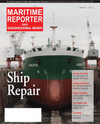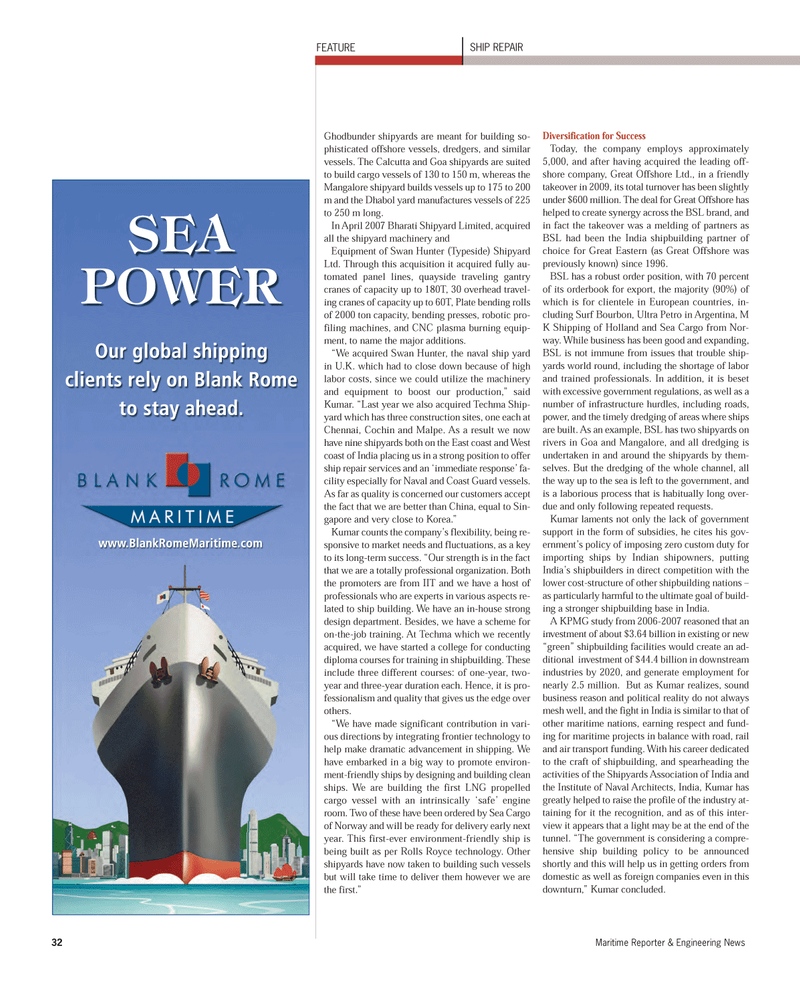
Page 32: of Maritime Reporter Magazine (March 2012)
The Ship Repair Edition
Read this page in Pdf, Flash or Html5 edition of March 2012 Maritime Reporter Magazine
32Maritime Reporter & Engineering News Ghodbunder shipyards are meant for building so- phisticated offshore vessels, dredgers, and similar vessels. The Calcutta and Goa shipyards are suited to build cargo vessels of 130 to 150 m, whereas the Mangalore shipyard builds vessels up to 175 to 200 m and the Dhabol yard manufactures vessels of 225 to 250 m long. In April 2007 Bharati Shipyard Limited, acquired all the shipyard machinery and Equipment of Swan Hunter (Typeside) Shipyard Ltd. Through this acquisition it acquired fully au- tomated panel lines, quayside traveling gantry cranes of capacity up to 180T, 30 overhead travel- ing cranes of capacity up to 60T, Plate bending rolls of 2000 ton capacity, bending presses, robotic pro- filing machines, and CNC plasma burning equip- ment, to name the major additions.?We acquired Swan Hunter, the naval ship yard in U.K. which had to close down because of high labor costs, since we could utilize the machineryand equipment to boost our production,? said Kumar. ?Last year we also acquired Techma Ship- yard which has three construction sites, one each atChennai, Cochin and Malpe. As a result we now have nine shipyards both on the East coast and West coast of India placing us in a strong position to offer ship repair services and an ?immediate response? fa- cility especially for Naval and Coast Guard vessels. As far as quality is concerned our customers accept the fact that we are better than China, equal to Sin- gapore and very close to Korea.? Kumar counts the company?s flexibility, being re- sponsive to market needs and fluctuations, as a key to its long-term success. ?Our strength is in the fact that we are a totally professional organization. Both the promoters are from IIT and we have a host of professionals who are experts in various aspects re- lated to ship building. We have an in-house strong design department. Besides, we have a scheme for on-the-job training. At Techma which we recently acquired, we have started a college for conducting diploma courses for training in shipbuilding. These include three different courses: of one-year, two- year and three-year duration each. Hence, it is pro-fessionalism and quality that gives us the edge over others. ?We have made significant contribution in vari- ous directions by integrating frontier technology to help make dramatic advancement in shipping. We have embarked in a big way to promote environ- ment-friendly ships by designing and building clean ships. We are building the first LNG propelled cargo vessel with an intrinsically ?safe? engine room. Two of these have been ordered by Sea Cargo of Norway and will be ready for delivery early next year. This first-ever environment-friendly ship is being built as per Rolls Royce technology. Other shipyards have now taken to building such vessels but will take time to deliver them however we are the first.? Diversification for Success Today, the company employs approximately 5,000, and after having acquired the leading off- shore company, Great Offshore Ltd., in a friendly takeover in 2009, its total turnover has been slightly under $600 million. The deal for Great Offshore has helped to create synergy across the BSL brand, and in fact the takeover was a melding of partners as BSL had been the India shipbuilding partner of choice for Great Eastern (as Great Offshore was previously known) since 1996. BSL has a robust order position, with 70 percent of its orderbook for export, the majority (90%) of which is for clientele in European countries, in-cluding Surf Bourbon, Ultra Petro in Argentina, M K Shipping of Holland and Sea Cargo from Nor- way. While business has been good and expanding, BSL is not immune from issues that trouble ship-yards world round, including the shortage of labor and trained professionals. In addition, it is besetwith excessive government regulations, as well as a number of infrastructure hurdles, including roads,power, and the timely dredging of areas where ships are built. As an example, BSL has two shipyards on rivers in Goa and Mangalore, and all dredging is undertaken in and around the shipyards by them- selves. But the dredging of the whole channel, all the way up to the sea is left to the government, and is a laborious process that is habitually long over- due and only following repeated requests. Kumar laments not only the lack of government support in the form of subsidies, he cites his gov- ernment?s policy of imposing zero custom duty for importing ships by Indian shipowners, putting India?s shipbuilders in direct competition with the lower cost-structure of other shipbuilding nations ? as particularly harmful to the ultimate goal of build- ing a stronger shipbuilding base in India. A KPMG study from 2006-2007 reasoned that aninvestment of about $3.64 billion in existing or new ?green? shipbuilding facilities would create an ad- ditional investment of $44.4 billion in downstream industries by 2020, and generate employment for nearly 2.5 million. But as Kumar realizes, sound business reason and political reality do not always mesh well, and the fight in India is similar to that of other maritime nations, earning respect and fund-ing for maritime projects in balance with road, railand air transport funding. With his career dedicated to the craft of shipbuilding, and spearheading the activities of the Shipyards Association of India and the Institute of Naval Architects, India, Kumar has greatly helped to raise the profile of the industry at- taining for it the recognition, and as of this inter- view it appears that a light may be at the end of the tunnel. ?The government is considering a compre- hensive ship building policy to be announced shortly and this will help us in getting orders fromdomestic as well as foreign companies even in this downturn,? Kumar concluded. FEATURE SHIP REPAIR MR March 12 # 4 (25-32):MR Template 3/2/2012 8:20 AM Page 32

 31
31

 33
33
